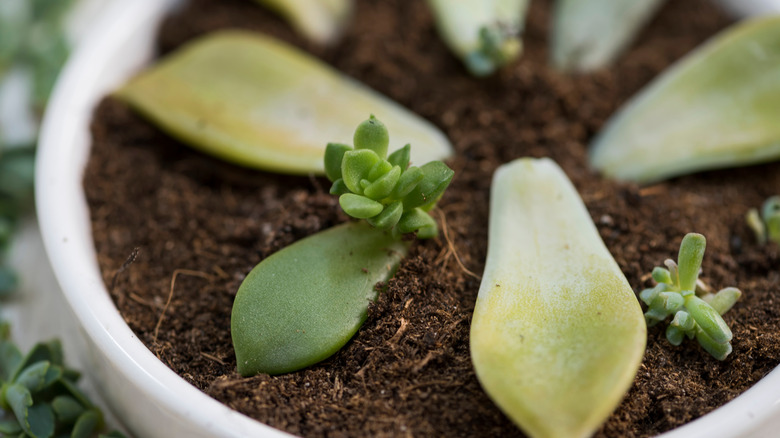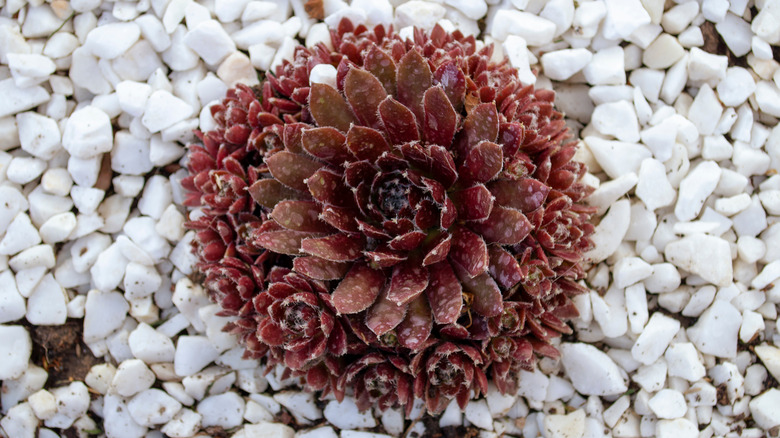Martha Stewart's Genius Tips Make Propagating Succulents A Total Breeze
Over the past few years, succulents have soared in popularity due to their unique charm and numerous appealing qualities. These resilient plants, with their fleshy leaves and striking forms, require minimal care and thrive in various environments. Martha Stewart endorses them on her blog, claiming "if you like growing plants, but don't really have the time to care for them properly, I encourage you to consider growing succulents." Their ability to store water makes them drought-tolerant, so they are ideal for busy individuals or those with limited gardening experience.
Available in an array of colors, shapes, and sizes, succulents offer endless possibilities in indoor and outdoor decor. While they're easy to care for, many of them are also easy to propagate yourself. If you're a little more adventurous and are looking to expand your collection, consider propagating your own succulents by simply removing a healthy leaf from the main plant and placing it on top of moistened soil. The leaf will eventually develop roots in the soil, forming a new plant that you can transplant and display in your home.
Steps for propagating succulents
For most succulents with fleshy leaves, like jade plants, sedum, or echeveria, propagation with a leaf requires a few simple steps, and a trip to the garden store for rooting hormone. On her blog, Martha Stewart recommends to "gently pull off a leaf from its stem, dip the torn end in water, and then into the rooting hormone." Be sure the plant you are propagating is healthy and well-hydrated to ensure the leaf has a good chance of rooting. Once you have removed the leaf, Stewart recommends placing it in a quarter-inch deep hole within a pot of succulent soil. Irrigate the soil and cover it with a clear glass bowl, allowing it to dry out between waterings. Alternatively, you could wait for your new plant to develop while making a statement piece by using a dining cloche to cover your propagated leaf. In a few weeks, your new succulent should be ready to transplant.
Stewart also claims on her blog, "If you'd like a larger result in less time, try propagating succulents by using stem cuttings." Take a two to four-inch stem cutting from a healthy succulent, wet the end, and dip it in rooting hormone. Similar to leaf propagation, the stem can be potted an inch and a half deep in succulent soil, watered, and covered to form a new plant. This method is also great because if you plant it directly in your desired pot, it does not require transplanting once the roots develop.
Martha Stewart's tips for succulent care
While succulents do require far less care than many other tropical household plants, they do still require some attention in order to thrive. On her blog, Martha Stewart mentions, "They are best planted in clay or terra cotta pots with proper drainage holes because the vessels dry quickly, and prevent water from building up." Stewart also mixes her own succulent soil with vermiculite, sand, perlite, and granulated organic fertilizer to create a well-draining soil, perfect to provide a more arid environment for drought-tolerant succulents. Once succulents are properly potted in this mix, she waters them thoroughly and deeply in order to encourage the roots to grow toward the bottom of the plant. Allow the plant to dry out in between waterings.
Another tip Martha Stewart has for taking care of succulents is to cover the top of the soil with pea gravel. This process is called mulching and helps to reduce evaporation and pest infestations while regulating the temperature of the soil. It can be done with other materials like coco coir, lawn clippings, bark mulch, or Spanish moss. Choose the medium that aligns best with the aesthetic of your home.

